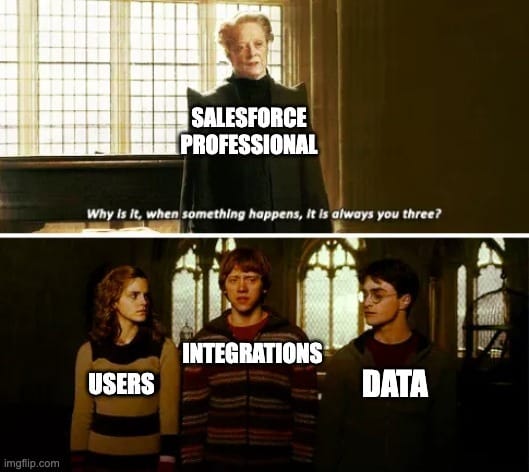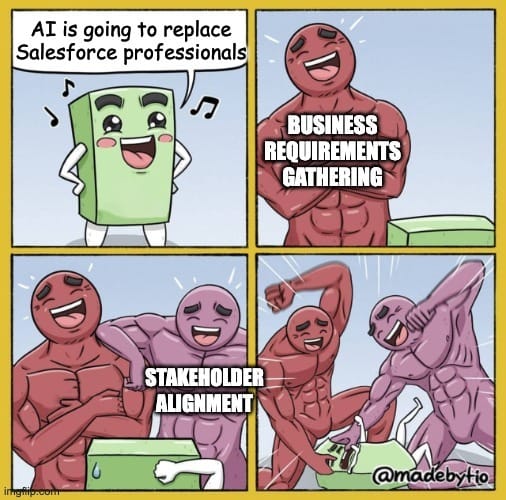- SalesforceChaCha
- Posts
- 💃 3 Teaching Methods for Salesforce Professionals 🕺
💃 3 Teaching Methods for Salesforce Professionals 🕺
Because teaching is more powerful than learning
Good morning, Salesforce Nerd! Let’s get this out of the way - no one has ever taught themselves out of a job - imparted so much retained knowledge they became dispensable.
Here’s another one - Teaching is better than Learning. Thought it was hard to become a Flow master? You’ll take your mastery to new heights if you able to teach others to become Flow experts 💯.
Ok, with all the speed bumps and headwinds removed, let’s talk 3 teaching methods that will immediately make you a better Salesforce professional 👇

WHY SHOULD YOU CARE?
Why Should You Teach?
Before we get into it, WHY does teaching make you a better Salesforce professional? 3 things-
💎 Clarity. When you teach, you have to strip complexity down to its core. And Salesforce is complex!
🤲 Empathy. Teaching requires understanding what your audience knows (and doesn’t know).
🕴️Influence. A Salesforce professional who can teach can also inspire adoption, win over stakeholders, and align executives.
LEARNING IS COOL. TEACHING IS COOLER.
3 Teaching Methods for Salesforce Professionals
The Feynman Technique
Richard Feynman was one of the greatest physicists that ever lived.
And he had a theory- if you can’t explain something in plain language, you don’t actually understand it.
For Salesforce professionals, this is gold 💛.
Let’s say you’re explaining record-triggered flows to a sales leader. If you start rattling off “before-save vs after-save contexts,” their eyes glaze over 😑.
But if you say, “Imagine Salesforce like a helpful robot- it can take action before the record is saved, like double-checking the math, or after it’s saved, like sending a confirmation email,” they’ll get it.
When you strip away jargon and teach it simply, you force yourself to really understand the concept. And your audience? They actually walk away smarter instead of more confused.
Duolingo Founder and His Mentor
“I would start explaining something, and in the first sentence he would say ‘I don’t understand what you’re saying,’ and then I would try to find another way of saying it, and a whole hour would pass and I could not get past the first sentence. He would say ‘Well, the hours over. Let’s meet next week.’” - Luis Von Ahn
That quote is from a story in this book, by Luis Von Ahn, founder of Duolingo, about his mentor who drove him absolutely nuts 🥜.
Luis was studying cryptography under his Manuel Blum.
Every time Luis explained something, the mentor would say, “I don’t understand.” Not once. Not twice. But until Luis could explain it so clearly that there was no room for confusion. It required Luis to boil the thing down to the simplest terms.
You know who your mentor is in Salesforce? Your stakeholders. That VP who keeps asking, “But what’s wrong with multi-select picklists?” Or that sales manager who interrupts, “Why can’t we just automate that when the close date comes up?”
Yes, it’s frustrating. But instead of rolling your eyes, treat it as the sharpening stone for your explanations. Each “I don’t understand” is your chance to refine until your teaching shines ✨.
1st Principles Teaching - Build from the Ground Up
Elon Musk (and many others) popularized first-principles thinking- break things down to their basic truths, then build up from there.
Teaching works the same way 🧑🏫.
In Salesforce, that might mean starting with:
Truth: Salesforce stores information in objects.
Next level: Objects are made up of fields.
Next level: Records are the actual data stored in those fields.
Now, when you explain why automation on Opportunity records needs the right field updates, you’re not piling on complexity, you’re stacking bricks on a solid foundation.
This level of teaching requires additional time and patience the others do not. It’s a good reminder that you need a tool chest 🧰 full of tools ⚒️ to manage the variety of responsibilities that a Salesforce professional encounters. For example-
Luis Von Ahn’s mentor’s approach is not going to fly with the executive team, but it pairs well with that genius developer who you need to communicate more effectively with stakeholders 🙌.
And first-principles is good for an eager first-year analyst who has dreams of being an Solutions Architect 👨🚀.
WHAT NOT TO DO!
DO NOT Spray and Pray
You’ve seen it. You may have done it yourself (I have…and still do!).
The “spray and pray” approach 😩.
Someone gets asked how Salesforce works and immediately launches into a monologue that covers APIs, validation rules, Lightning pages, and why their favorite Trailhead badge is underrated…all in one breath 😮💨.
This is not teaching, it’s brain-puking 🤮. It’s like opening every tab in your browser at once and expecting someone else to make sense of it.
When you spray and pray, you leave your audience more confused than before.
Avoid spray and pray!
FINAL THOUGHTS
Takeaway
Here’s the career secret no one tells Salesforce professionals 👇
The best teachers rise the fastest.
Why?
Because teaching creates alignment, trust, and momentum. Your stakeholders trust you. Your users adopt what you build. Your execs see your value.
Enhancing your teaching tools to enhance your teaching other people which will enhance your career 🚀!
SOUL FOOD
Today’s Principle
"We are stubborn on vision. We are flexible on details." - Jeff Bezos
and now....Your Salesforce Memes



What did you think about today's newsletter? |